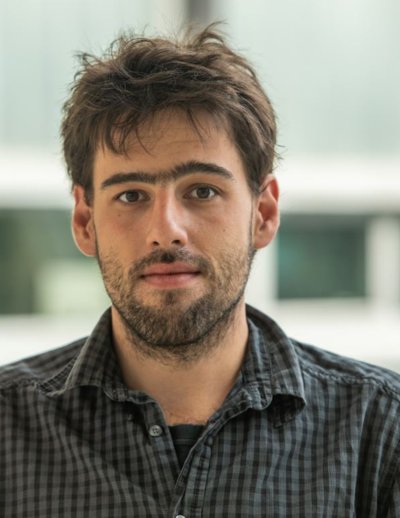wetting and dewetting effects of bubbles, drops and solids
Ivan Dević is a PhD student in the Physics of Fluids group. His supervisor is prof.dr. D. Lohse from the faculty of Science and Technology.
 In this thesis, we investigated wetting interactions with many types of patterned substrates and with various interactions such as a general concept of the body force and the disjoining pressure. Although the two core results of the wetting theory (Young's law and Young-Laplace equation) are always observed, with increasing complexity of a pattern many "side-effects" are noticed.
In this thesis, we investigated wetting interactions with many types of patterned substrates and with various interactions such as a general concept of the body force and the disjoining pressure. Although the two core results of the wetting theory (Young's law and Young-Laplace equation) are always observed, with increasing complexity of a pattern many "side-effects" are noticed.
In Chapter 2 we have analysed interplay between wetting effects, the disjoining pressure and the gas compressibility. The given theoretical framework has a diverging interaction at the substrate, therefore the current problem cannot truly resolve the contact line properties. The distortion caused by disjoining pressure is only observable very close to the contact line, where the bubble obtains a shoulder-like shape, while the shape far away from the contact line is a spherical cap. Main result is the existence of a threshold aspect ratio for which boundary conditions are satisfied and the threshold aspect ratio approaches the aspect ratio dictated by the Young's law and the Young-Laplace equation without the disjoining pressure, as we increase the bubble height.
Chapters 3 and 4 deal with wetting problems on patterned substrates. In Chapter 3 we analysed the system of a flat substrate decorated with microcaps. The given geometry is convenient, since the droplet will have a shape of a truncated spherical cap due to symmetry of the sphere-sphere intersection. Analysis of equilibrium shapes reveals that the droplet position, whether it is on the microcap, the flat substrate or at the microcap rim, is only dictated by values of surface tensions present in the system and is completely independent of the droplet size. Although we obtain numerically a linear expression for a threshold wetting scenario from numerics, this expression seems non-obtainable analytically. In Chapter 4 we show that the curvature plays as important role as does the equilibrium contact angle. Depending on the aspect ratio of the lyophilic elliptical patch, the droplet in a quasi-steady grow will either completely wet the patch or it will start spreading on the lyophobic part of the substrate, although there is a finite amount of the lyophilic patch available to the droplet. Additionally, in this work we also show that the Metropolis stochastic algorithm is capable of minimising the interfacial energy as precise as the energy gradient method (Surface Evolver). In Chapter 5 we introduce an external body force to the droplet. Although many experimental and numerical studies were performed on sliding drops, hereby we present a full thermodynamical calculation of equilibrium shapes. Qualitative difference between present work and the literature is that we have included the contact energy in our calculation, while so far a more common approach was to model contact angle hysteresis, instead of calculating the contact energy. We identify two types of threshold shapes, where in one case the droplet cannot satisfy Young-Laplace equation smoothly, while in the other case the droplet would have tendency to go inside the substrate, due to the curvature becoming negative at some parts of a droplet interface.
In Chapter 6 we have developed the marker numerical code for simulating the process of the solid-state dewetting. We have researched the effect of substrate physical singularities on the solid dynamics. The contact line behavior in the geometrical singularity shines light on a lot of novel qualitative properties of solid-state dewetting, namely, the contact line will not unpin itself from the singularity if the complete morphology is close to the equilibrium shape and the convergence to the equilibrium shape has two modes, where the time needed to reach the equilibrium shape can be an order of magnitude smaller in a faster mode. Natural enquiry which arose is how does this effect affect the solid-state dewetting once there are many possible solutions to the Young-Laplace equation. This question was tackled in Chapter 7, where we introduce the chemical patterning to the solid-state dewetting research. While this induces many complex contact line behaviours, the main result of this chapter is that the solid-state dewetting is completely a contact line driven problem. While this result might not come as a surprise to some of you, solid-state dewetting on a striped pattern shows that it does not prefer to go to the global energy minimum, but rather converges in the first available equilibrium shape, independent of the energy value of that same equilibrium.





